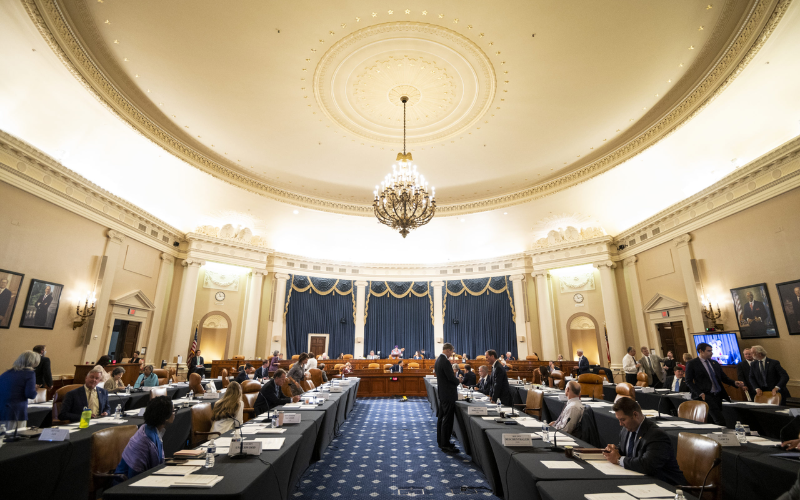Welcome to the May edition of A Capitol View
Investments in marine energy and hydropower technologies have long lagged behind wind, solar, and other energy generation and storage technologies.
But SMI is partnering with some of the leading water power innovators this legislative session to sharpen the policies and budgets that could unleash what is widely regarded as an untapped clean energy resource.
Legislation being drafted by Rep. Nanette Barragán of California, a member of the House Energy and Commerce Committee, would authorize $1 billion for research and demonstration, to conduct additional assessments of resource locations, improve the permitting process, and grow the marine energy workforce.
Facts and figures: The National Renewable Energy Laboratory, a research arm of the Department of Energy, estimates that marine energy resources could provide 2,300 terawatt hours per year, which would amount to more than half of all U.S. electricity generated in 2021.
“Safely utilizing just one-tenth of these resources equals 5.6% of total electricity generation that year and could power over 22 million homes,” according to the National Hydropower Association.
‘Untapped’: The Multi-Year Program Plan published by DOE’s Water Power Technologies Office estimates that “up to 50 GW of marine energy capacity could be added in the U.S. by2050.”
“The United States has significant untapped water power resources that can be safely captured and converted into clean, renewable electricity,” nearly three-dozen House members wrote to leaders of the House Appropriations Committee in May.
They called for “robust funding” for the Water Power Technologies Office, to the tune of $225 million in fiscal 2025, to “speed up technology commercialization, help provide low cost, clean power for our grid, reduce harmful emissions, and create good-paying jobs.”
The money would “support research, development, and deployment of marine energy technologies, new innovative hydropower, and pumped storage,” they added.
‘Real opportunity’: “Marine energy is a real opportunity,” says SMI VP Paul Gay. “However, the name ID for the sector is low. This leads to lower levels of federal funding that is critical to commercializing domestic advanced water power technologies, whether that be for hydropower or marine energy.”
Paul briefed the Ocean Renewable Energy Conference in Portland, Oregon, last month on marine energy policy at a crossroads.
One major push this year is to allow DOE to award project funds over multiple years, “with a focus on more mature systems nearing market adoption or to advance, improve, or complete ongoing testing and validation awards,” Paul reported. “We are also working to allow the new Office of Clean Energy Demonstrations to invest in marine energy technology deployments.”
Murky waters: The Biden administration cut water power funding by 20 percent in its budget request for DOE, from $141 million this year to $112 million in FY25.
Meanwhile, SMI helped secure $23 million in the Navy budget this year for marine energy systems and is advocating for an additional $35 million in the FY25 budget for wave and tidal energy technology R&D to power sensors, microgrids, and at-sea charging for Unmanned Undersea Vehicles.
One of the most promising efforts is the PacWave project at Oregon State University, an open ocean wave energy testing facility near the deep-water port of Newport, Oregon. The SMI client is gearing up for installation of subsea and terrestrial power cables this summer.
More new developments: U.S. research program backs eleven marine energy projects.
BUDGET
OPENING SALVOS: The first stab at the House version of the fiscal 2025 Defense Appropriations Act is trickling out, as the contours of the next federal budget begin to take shape on Capitol Hill.
The legislation calls for $833 billion in defense spending for the fiscal year that starts Oct. 1, a one percent increase. That’s in line with the spending limits under the Fiscal Responsibility Act. More details will come out before the House Appropriations Committee marks up the bill on June 13 and releases the full report and funding tables.
‘Welcome news’: One early takeaway is the bill’s emphasis on increased funding for defense innovation, says SMI Director Nicholas Vance. For example, the proposed bill provides over $1.3 billion for the Defense Innovation Unit and other DoD innovation efforts for rapid experimentation and procurement.
“Even with the topline pressures from the Fiscal Responsibility Act, House appropriators are opting to heavily invest in the defense innovation ecosystem,” Nick says. “This is welcome news for companies facing the ‘valley of death’ or those doing work with budget-constrained innovation organizations.”
What’s next: No firm dates yet for Senate action, a process that SMI Director Celia Morté predicts is “likely delayed based on on-going negotiations and the reality of the Senate’s schedule.”
A wider lens: Catch up on the status of all the annual appropriations bills with the Committee for a Responsible Federal Budget.
NDAA UPDATE: June is also a big month for the National Defense Authorization Act, the annual legislation that sets policy for the Department of Defense and related national security programs.
The GOP-controlled House is poised to debate the armed services panel’s bipartisan version and consider hundreds of amendments. We’re tracking a series of new provisions, including a number aimed at better preparing the military for climate change and developing more domestic sources of critical minerals.
Boosterism: The Senate Armed Services Committee, which will mark up its version of the NDAA in the coming days, is expected to recommend a larger budget that busts the spending caps.
“Democrats are bracing for potential defections in favor of Sen. Roger Wicker’s push to boost defense spending by $55 billion,” says Celia. “Wicker is expected to offer his proposal as an amendment to the SASC NDAA at its markup starting June 11.”
DOMESTIC MANUFACTURING
 FORGING AHEAD: Several SMI clients took their policy priorities directly to the Office of the U.S. Trade Representative.
FORGING AHEAD: Several SMI clients took their policy priorities directly to the Office of the U.S. Trade Representative.
The Forging Industry Association (FIA) advocated for more competitive trade policies – including instituting higher tariffs – and closing loopholes that are allowing Chinese and other imports to crowd out domestic forgings and undermine national and economic security.
“Over the past two decades, manufacturers watched in real time as China increased exports, leaving China in control of 46 percent of the global forging market,” Angela Gibian, FIA’s deputy chief executive, testified at a public hearing that USTR convened on “Promoting Supply Chain Resilience.”
“Trade laws should work in real time to prevent this type of market concentration, so the ‘next China’ does not undermine domestic supply chains,” she added.
Tariff troubles: FIA also called for higher tariffs on forgings and other products that Gibian described as “of national security and economic significance” in order to further protect the domestic supply chain.
She also emphasized the importance of updating America’s trade laws to ensure that foreign competitors do not have the ability to evade tariffs or duties and undermine domestic supply chains. “The U.S. needs to update its system of trade laws to adapt to today’s global strategy of evading tariff actions through tactics including through transshipment and transnational subsidies,” Gibian testified.
Read more: FIA Testifies Before U.S. Trade Representative on Tariff Evasion.
The full testimony: USTR Supply Chain Virtual Hearing.
Plus: President Biden Takes Action to Protect American Workers and Businesses from China’s Unfair Trade Practices.
‘CHALLENGES REMAIN’: Also testifying at the hearing was SMI Director Karlee Popken, who also serves as the trade policy director for the United States Footwear Manufacturers Association (USFMA).
She highlighted the strides being made in expanding domestic production and urged more aggressive federal government policies on trade to promote continued growth.
‘A linchpin’: The footwear industry “serves as a linchpin for demand in yarns, fabrics, and foams essential for various medical devices, emphasizing the industry’s commercial viability and its broader contribution to national emergency preparedness,” Popken testified.
During her testimony, she also outlined a series of trade policy priorities for USFMA, including support for expanded tariffs on Chinese goods; “a broader embrace of Free Trade Agreements (FTA) with our partners in the Western Hemisphere”; and policies that “carefully and strictly outline” requirements that limit the exploitation of FTA by adversary nations that ship goods via third countries.
FIA and USFMA appeared at the USTR hearing along with representatives of other domestic industries, including retail, construction, solar energy, and mining.
Read more: USFMA Trade Policy Director Testifies To Office Of U.S. Trade Representative.
‘A UNIQUE SET OF SKILLS’: USFMA last month enlisted Caroline de Baere, a footwear industry veteran and educator, as a strategic advisor.
De Baere, who has supported leading brands, designers, and suppliers, will focus on expanding USFMA’s membership.
“We are thrilled to have her on our team as we continue to expand collaboration, build a more resilient supply chain, and press for smarter policies that help make our industry more competitive and create additional skilled jobs,” said SMI CEO and USFMA Executive Director Bill McCann. “She brings a unique set of skills and contacts that have already paid dividends.”
Read more: USFMA enlists footwear industry veteran Caroline de Baere.
DEFENSE
 SUPPORTING WARFIGHTERS: SMI client University of Massachusetts Lowell hosted the inaugural military footwear industry day with the Army’s Combat Capabilities Development Command, to showcase new footwear technologies and funding opportunities to improve military readiness and strengthen the domestic capacity.
SUPPORTING WARFIGHTERS: SMI client University of Massachusetts Lowell hosted the inaugural military footwear industry day with the Army’s Combat Capabilities Development Command, to showcase new footwear technologies and funding opportunities to improve military readiness and strengthen the domestic capacity.
The Supporting Warfighters through Innovative Footwear Technologies (SWIFT) program has been funded by Congress to enlist U.S. textile manufacturers, suppliers, and universities to pursue inventive solutions to the unique footwear challenges faced by military personnel.
Homefront: The funding for prototyping and piloting new technologies, including an additional $10 million appropriated this year, is also intended to strengthen the Berry Amendment, which restricts the use of federal funds for military clothing, fabrics, and other textiles “not grown, reprocessed, reused, or produced in the United States.”
“This is to build upon what we can do here in the U.S.,” said Anita Perkins, an Army footwear engineer. “A lot of the technology over the years providing footwear has been transferred overseas.”
“New technologies like robotics, additive manufacturing, data analytics and artificial intelligence have increased automation and reduced the cost-of-labor advantages that countries like China and Vietnam have over the U.S.,” McCann told attendees. “Also, the pandemic exposed us as a nation that has a hard time making what we need in a crisis, and that has spurred a lot of entrepreneurship and investment in our industry and rebuilding our supply chain.”
Read more: UMass Lowell hosts industry leaders to highlight innovations in military footwear.
Plus: Congressionally Funded Program Aims to Improve Footwear for U.S. Troops.
SUPPORTING SMALL BIZ: SMI COO Ken Wetzel was a featured speaker at the DIBCON24 Defense Industrial Base Conference in Oklahoma City, where he shared lessons on how small and medium-sized businesses must play a bigger role in the defense industrial base.
Ken was joined by experts from the Air Force and Blue Forge Alliance, the coalition dedicated to developing 100,000 skilled workers to help transform the Navy’s nuclear-powered submarine force.
TECHNOLOGY
 ‘JUST STARTING’: SMI client Tiburon Subsea, Inc. and CEO Tim Taylor has located the wreckage of the USS Harder, the legendary U.S. Navy World War II submarine, honoring the memory of its 79 submariners who were lost on August 24, 1944.
‘JUST STARTING’: SMI client Tiburon Subsea, Inc. and CEO Tim Taylor has located the wreckage of the USS Harder, the legendary U.S. Navy World War II submarine, honoring the memory of its 79 submariners who were lost on August 24, 1944.
The discovery, at a depth of 3,750 feet in the South China Sea, is the ninth vessel to be located under the Lost 52 Project that Tim Taylor founded to search for lost WWII submarines and collaborate on other cultural expeditions involving underwater historic sites.
‘The blue economy’: The firm has pioneered technology that enables remotely operated undersea vehicles to gather subsea data much more efficiently. Tiburon Subsea is building a global fleet of Hovering Autonomous Underwater Vehicles “that are faster, more maneuverable, more reliable, and more versatile than current coastal survey vehicles.”
“The ocean is our life on this planet,” Taylor told NBC News. “People don’t understand there’s so much involved – with fisheries and energy and weather. We are just starting to study them. We are just starting to understand them. The blue economy is like a one and half trillion-dollar economy. By 2030, it will be a three trillion-dollar economy. A large part of it is collecting data and understanding what’s out there.”
Watch: Veteran ocean explorer discovers WWII submarine in South China Sea.
ENERGY
GREATER INCENTIVES: SMI’s first-in-class energy team is closely tracking the latest efforts to spur more investment in clean energy, including new IRS guidance on production tax credits.
In early June, the Biden administration published a proposed rule for Clean Electricity Tax Credits that are designed to “provide the ability for new zero greenhouse gas emissions technologies to develop over time, while also providing long-term clarity and certainty to investors and developers of clean energy projects.”
The categories: The proposed rule singled out wind, solar, hydropower, marine and hydrokinetic, nuclear fission and fusion, geothermal, and waste energy recovery technologies.
The credits are part of a larger historic, bipartisan “investment boom” spurred by recent legislation, including the Inflation Reduction Act and Bipartisan Infrastructure Law (BIL).
Under the BIL alone, the Biden administration has announced nearly $454 billion in funding for over 56,000 projects in 4,500 communities in every state, territory and tribal jurisdiction.
See where it’s all going in this interactive map.
 ‘REVOLUTIONIZING’: SMI client Anthro was singled out as an “emerging innovator” in an assessment by Booz Allen Hamilton of the 10 top emerging national security technologies.
‘REVOLUTIONIZING’: SMI client Anthro was singled out as an “emerging innovator” in an assessment by Booz Allen Hamilton of the 10 top emerging national security technologies.
The company “is revolutionizing the field of high-density energy storage with its cutting-edge batteries,” the study said, citing its AdhesION Polymer Electrolyte technology “that enables the batteries to be safe, flexible, and high performing, even in harsh environments.”
Drones and more: “This technology is ideal for auxiliary military equipment like drones and robotics, where space and weight are critical factors,” Booz Allen added.
The report added that by relying on silicon anode and solid-state batteries, Anthro Energy “can deliver more power and longer life to these applications while reducing the risk of fire or explosion.”
The intent of the research study, Booz Allen chief technology officer Susan Penfield explained, was “to call attention to the technologies our research says should be prioritized in the near term.”
CRITICAL MINERALS
 ‘A BIG STEP’: The Pentagon took a historic move in weaning the U.S. off foreign sources of critical materials with the first-ever investment in producing battery-grade manganese.
‘A BIG STEP’: The Pentagon took a historic move in weaning the U.S. off foreign sources of critical materials with the first-ever investment in producing battery-grade manganese.
The $20 million is slated for SMI client South32’s Hermosa Project in Santa Cruz County, Arizona, that is sustainably producing battery-grade manganese.
A top priority: The award, under the Defense Production Act Investment Program, advances one of the top priorities of the recently completed National Industrial Base Strategy in expanding domestic production of critical materials.
“This first DPA award for manganese production is a big step towards reducing import dependency throughout the battery material supply chain,” said Anthony Di Stasio, acting Deputy Assistant Secretary of Defense for Industrial Base Resilience.
Manganese is used in batteries for military and civilian applications and the Pentagon said the DPA funding will accelerate the delivery of ore by as much as two years.
Read the announcement: DOD Awards $20 Million to Enhance Domestic Manganese Supply Chain.
CLIENTS IN THE NEWS





